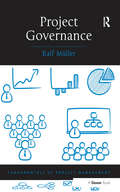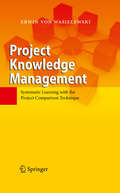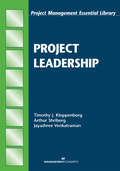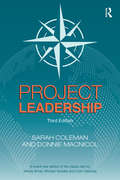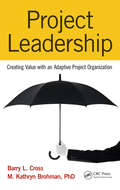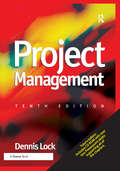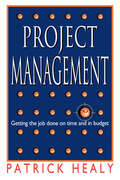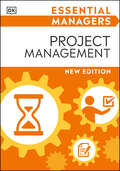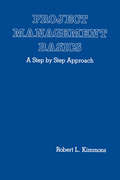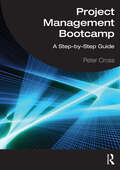- Table View
- List View
Project Finance: Structuring, Valuation and Risk Management for Major Projects (Management for Professionals)
by B Rajesh KumarLarge projects are defining moments for companies and countries. When large projects succeed, they can dramatically improve the social and economic conditions in a region. This book focuses on major aspects of the world’s largest infrastructural, industrial and public service projects through the lens of structuring, valuing, managing risk and financing projects. The book analyses and discuss large projects in government, private and public and private partnership. The author sheds light into the attributes of project finance which have unique structural elements. The book focuses on case studies related to 50 mega projects which includes infrastructural projects, energy related projects, industrial projects, roads, ports and bridges among others. This book covers both the theoretical aspects of financing of mega projects and the practical applications by including case studies of the world’s largest projects in terms of value.
Project Financing: Asset-Based Financial Engineering
by John D. FinnertyA timely update to one of the most well-received books on project financing As an effective alternative to conventional direct financing, project financing has become one of the hottest topics in corporate finance. It's being used more and more frequently-and more successfully-on a wide variety of high-profile corporate projects, and has long been used to fund large-scale natural resource projects. But the challenges of successful project financing are immense, and the requirements of the process can easily be misunderstood. That's why John Finnerty has returned with the Third Edition of Project Financing. Drawing on his vast experience in the field, Finnerty takes you through the process step by step. Using updated examples and case studies that illustrate how to apply the analytical techniques described in the book, he covers the rationale for project financing, how to prepare the financial plan, assess the risks, design the financing mix, raise the funds, and much more. Includes completely new chapters that cover the financing of sustainable projects as well as Sharia-compliant (Islamic) project financing New material has been added to the discussion of financial modeling and international debt financing Explores today's most innovative financing techniques and analyzes the shortcomings of unsuccessful project financing attempts Whether you're a corporate finance professional, project planner, or private investor, Project Financing, Third Edition demystifies the complexities of project financing and provides an invaluable guide for anyone who wants to master innovation in corporate finance today.
Project Governance
by Terry M. WilliamsLarge projects are complex undertakings representing major investments. Often problems arise because of failure at the start of a project in terms of establishing governance, choosing the appropriate concept, analyzing the proposal and environment, and maximizing the utility of the investment, all within complex and political decision-making structures. As a result, many projects fail even though they were implemented successfully, simply because the project concept was wrong. While attention has been paid to project execution, this area is under represented in literature. However, considerable advances have been made, both practical and in putting the behaviour and management of major projects on a proper theoretical basis. This volume therefore provides a resume of the state of this domain. It is a guide for practitioners, decision-makers and their advisors, as well as students. It takes a narrow view of the project, widening to place it within the organization, then the organizational nexus, and finally the political environment, to give a holistic view on how bad ideas can be avoided and good ideas developed into successful projects. "
Project Governance (Fundamentals of Project Management)
by Ralf MullerWithout a governance structure, an organization runs the risk of conflicts and inconsistencies between the various means of achieving organizational goals, the processes and resources, causing costly inefficiencies that impact negatively on both smooth running and bottom line profitability. However, the frequency of projects failing to meet these corporate objectives has focused attention firmly on the process of project governance. In this book, Ralf Müller provides a well-researched framework to explain the different preferences organizations have in goal setting, along with the best-practices, roles and responsibilities related to governance tasks. This concise text is an important guide for project and programme managers, those managers concerned with corporate governance such as risk managers and internal auditors, project sponsors and project board members, as well as academics researching organizational and project performance. Project Governance is part of the Gower Fundamentals of Project Management Series. Practising professionals and project students will find in the fundamentals a definitive, shorthand guide to each of the main competencies associated with project management; a book that is authoritative, based on current research but immediately relevant and applicable.
Project Helios: Harvesting the Sun
by E. Scott Mayfield Mark Egan"In late 2017, Ashley Telkes gazed across the sunlit woods adjacent to her home near Boston, Massachusetts. The sunny day reminded her of the decision she needed to make regarding her home. A marine biologist, Telkes was acutely aware of the impact that modern society was having on the environment and, to this end, she had tried to be cognizant of her own impact on the environment. Since purchasing her home, Telkes had pursued a number of passive measures to minimize her “carbon footprint,” including re-insulating the roof and walls, opting for ceiling fans instead of air conditioning, and replacing incandescent lights with energy efficient LED bulbs. However, she was now confronted with a much bigger decision: whether or not to invest in solar panels to generate electricity for her home."
Project Identification: Capturing Great Ideas to Dramatically Improve Your Organization
by Jr., Charles TryonOrganizations of every type struggle to remain relevant in their marketplace. They continuously strive to introduce new products and services at a rate that satisfies their customers. In their search for fresh ideas, organizations often overlook the most significant source of new thought- their employees. Today's employees are knowledgeable and able to see opportunities or solutions to problems. This book describes a process for turning great ideas into actionable proposals. It presents a simple, but powerful set of questions that has proven to deliver a never-ending stream of inspiration to an organization.
Project Knowledge Management
by Erwin Von WasielewskiThis is the first English book on Project Comparison Technique, i.e. comparative project prognoses, project theory, project evaluation, and project benchmarking in all branches. It facilitates the first steps towards project comparisons for project management experts and scientists, details possible approaches and relates real-world experiences. While readers are assumed to have some knowledge of project management, the mathematical and statistical aspects are explained. For the first time in the history of project management we show that the efficiency of project realizations can be evaluated objectively and numerically in detail and as a whole, and how to do so. We lay out the first comprehensive, scientifically founded characteristics system for projects, formulate the first mathematical project model, demonstrate the usefulness of the characteristics system with authentic projects, and show how to handle the new tools and how to present them in tables and diagrams.
Project Leadership
by Timothy J. Kloppenborg PhD, PMP Arthur Shriberg EdD Jayashree Venkatraman MS, MBAThis book traces the development of project leadership as fundamental to completing projects effectively, delineates the leadership tasks that must be accomplished at each step of a project's life, and helps the reader develop wisdom in making decisions both by learning the ramifications of certain decisions and by seeing how those decisions are made in an example project.
Project Leadership (Advances In Project Management Ser.)
by Sarah Coleman Donnie MacNicolProject Leadership, the classic, best-selling textbook originally by Wendy Briner, Michael Geddes and Colin Hastings, anticipated so many of the changes in approaches to project management that are now regarded as mainstream - not least the focus on behaviours. The Third Edition by experts Sarah Coleman and Donnie MacNicol has been substantially rewritten, introducing new material and experience reflecting the transformation that has taken place in the world of projects and leadership. Project Leadership Third Edition looks at the nature of the leadership role in projects, why it is significant and how it impacts the processes throughout the project life-cycle from shaping and scoping, start up and delivery through to project closure. The authors put considerable emphasis on a set of core capabilities around the themes of vision and strategy, relationship building, communication and engagement. The book also focuses on building personal and organizational project leadership capability including models, tools and diagnostics drawing on experiences of working with projects and organizations from multiple sectors and across the globe. The Foreword and Endorsements have been provided by industry leaders. Sarah Coleman and Donnie MacNicol have retained and built on the wonderful range of simple, imaginative and very applicable models and perspectives developed by the previous authors. Every project leader, aspiring project leader and organization with project management communities should own and use a copy of this book.
Project Leadership: Creating Value with an Adaptive Project Organization
by Barry L. Cross M. Kathryn BrohmanLook around your organization: can you identify who owns project management? Would that person appreciate that they own responsibility for your projects? Project Leadership: Creating Value with an Adaptive Project Organization highlights the importance of these questions underlining the importance not only of the project team but on the culture of
Project Life Cycle Economics: Cost Estimation, Management and Effectiveness in Construction Projects
by Massimo PicaThe financing of modern construction projects reflects the need to address the costs and benefits of the whole life of the project. This means that end of life economics can now have a far greater impact on the planning and feasibility phases. During the project itself, decisions on construction materials and processes all influence the schedule as well as both immediate and down-the-line costs. Massimo Pica and his co-authors explain in detail the fundamentals of project life cycle economics and how they apply in the context of complex modern construction. This is an essential guide for those involved in construction project design, tendering and contracting; to help ensure the sustainability of the project or their contribution to it, from the start. It is also important for those involved in the delivery of the project to help them make the choices to keep the project on a financial even keel. Government, corporations and other organizations are looking for new models of collaborative working to fund their large construction and infrastructure projects in the face of changing attitudes to risk; a better educated and more demanding base of end-user clients and the increasing requirements for projects that are environmentally responsible and sustainable. Project Life Cycle Economics is a fundamental primer for those commissioning and those delivering construction.
Project Maji: Pricing Water in Sub-Saharan Africa
by Esel Cekin Elie Ofek Marco Bertini Dilyana Karadzhova BothaIn July 2021, Sunil Lalvani, founder and CEO of Project Maji, a non-profit social enterprise headquartered in Dubai that had already provided sustainable, clean water solutions to 80,000 people living in rural communities across Ghana and Kenya, was facing an important decision. Traditionally, fees collected from community members covered the operating and maintenance costs of the solar-powered water kiosks, while donations paid the initial capital expenditure and setup costs. Yet Lalvani needed a more scalable financing solution to reach a hefty goal: impacting 1 million lives by 2025. Serving larger, more affluent peri-urban communities was a viable alternative, as the additional revenue could be channeled to rural projects. Thus, Lalvani and his team worked on a pilot for three peri-urban sites and looked to Danone Communities, a venture capital fund that invested in social businesses, to provide a loan. The team mapped out a feasible system, but debated what fees to charge residents. A low price meant that Project Maji would pay off the loan for the first four years, and only then start accumulating funds to support its activities in rural areas. This would delay scaling. Alternatively, a high price, coupled with an offer to establish direct connections in more well-off households, would allow Project Maji to generate excess earned revenue from the get-go, but it would also raise questions of equitability. All of this weighed on Lalvani as he pondered what price point to include in the investment proposal.
Project Management
by Jeffrey Haynes Axzo Press StaffBuild a building. Develop software. Relocate your office. Whatever initiative you need to accomplish, the proven principles of Project Management will help you achieve success. Developed as a discipline during the U.S. space program, today Project Management helps businesses and their leaders identify and leverage the talent, facilities, techniques and finances to achieve their objectives.
Project Management
by Dennis LockDennis Lock's masterly exposition of the principles and practice of project management has been pre-eminent in its field for 45 years and was among the first books to treat project management as a holistic subject. But Project Management has been kept completely up to date by regular and sensitive revisions to ensure that it remains fresh and totally relevant. Project Management explains the entire project management process in great detail, demonstrating techniques from simple charts to detailed computer applications. Everything is reinforced with clear diagrams and case examples, many new for this edition. The author has expanded discussion of topics such as supply chain management and the project management office (PMO), and there are new chapters about implementing change management projects and the role of senior managers in supporting projects. Obsolescent or less frequently used methods have been stripped out, but readers of the hardback Tutor’s Edition will find that this deleted material lives on as new chapters on the accompanying downloadable resources, which have been thoroughly revised. Importantly, that disc includes comprehensive Power Point presentations with hundreds of well designed slides that tutors can use directly as a valuable resource for their lectures. Students have always commented on this book’s reader-friendly style, which is free of unnecessary jargon, with clear diagrams and a construction that is logically organized, well indexed and simple to navigate. This Tenth Edition is certain to maintain the book's acclaimed status as the standard work for managers and students alike.
Project Management
by Patrick HealeyFirst Published in 1998. Routledge is an imprint of Taylor & Francis, an informa company.
Project Management &Leadership Skills for Engineering & Construction Projects
by Barry Benator Albert ThumannProject management is the key to any engineering and construction project's success. Now you can learn from the experts real-world tested strategies you can use to lead your projects to on-time, within budget, high quality success stories. Specifics of scheduling, cost estimating and leadership skills are fully detailed. The authors will show you how to organize your project from the very beginning to achieve success. You'll also learn to use win-win negotiation skills during each stage of your project. Real world examples will facilitate your understanding of how to apply every aspect of the material presented in the text. Loaded with forms, checklists and case studies, this invaluable reference is a must for everyone involved with engineering and construction projects.
Project Management (2nd Edition)
by Jeffery K. PintoProject Management employs a managerial, business-oriented approach to the management of projects, which is reinforced throughout the text with current examples of project management in action. Introduction: Why Project Management?; The Organizational Context: Strategy, Structure, and Culture; Project Selection and Portfolio Management; Leadership and the Project Manager; Scope Management; Project Team Building, Conflict, and Negotiation; Risk Management; Cost Estimation and Budgeting; Project Scheduling: Networks, Duration Estimation, and Critical Path; Project Scheduling: Lagging, Crashing, and Activity Networks; Critical Chain Project Scheduling; Resource Management; Project Evaluation and Control; Project Closeout and Termination For readers or future mangers interested in understanding the fundamentals of project management from a variety of business applications and examples.
Project Management (CRC Press Revivals)
by Paul C. TinnirelloProject Management covers the full range of issues of vital concern to IT managers working in today's hurry-up, budget-conscious business environment. The handbook provides valuable advice and guidance on how to get projects finished on-time, within budget, and to the complete satisfaction of users, whether a high-tech, low-tech, financial, manufacturing, or service organization. Project Management Handbook brings together contributions from an all-star team of more than 40 of experts working at leading enterprise organizations and consulting firms across America, and around the world. With the help of dozens of fascinating and instructive case studies and vignettes, reporting experiences in a wide range of business sectors, those experts share their insights and experience and extrapolate practicable guidelines and actions steps that project managers can put to work on their current projects.
Project Management (DK Essential Managers)
by DKDiscover the ultimate practical guide to effective project management.Packed with clear, expert advice, bold graphics and bite-sized text, this beginner&’s guide to modern project management gives you the tools you need to manage a team in different locations/time zones.Inside the pages of this project management book, you&’ll find: • Practical, &“how-to&” approach that teaches you the skills you need to run a project successfully. • New spreads with tools for project managing teams who are working remotely. • Step-by-step instructions, tips, checklists and &“Ask yourself&” features that show you how to make an impact. • Tables, illustrations, &“in-focus&” panels and real-life case studies that demonstrate and explain problem-solving, and how to build confidence and get results. Learn how to improve your project management skills by defining a project brief, analyzing stakeholders and building a strong team. You'll also discover useful tips for initiating projects, delegating effectively and achieving your goals on budget and on time — every time.Essential Managers Project Management shows you how to focus your energy, manage change in the workplace and make an impact, even in a time when remote — and flexible — working plays a key role in business and management. It&’s the perfect book for managers of all levels.Whether it&’s negotiating, managing people or improving your leadership skills, DK's Essential Managers series contains the know-how you need to be a more effective manager and hone your management style.
Project Management (Sixth Edition, Idiot's Guides)
by G. Michael CampbellSuccessful project management requires organization, skill, and a systematic approach to ensure that projects are delivered on time and on budget. For both small and large organizations, Idiot's Guides: Project Management, Sixth Edition, is fully updated and includes coverage on the Fifth Edition of PMBOK (Project Management Body of Knowledge). Covering all of the latest methodologies, this new, step-by-step edition includes updated assessment questions for the PMP certification exam and content that aligns with the knowledge areas as the PMI (Project Management Institute) defines them.
Project Management Accounting: Budgeting, Tracking, and Reporting Costs and Profitability (Wiley Corporate F&A #565)
by Kevin R. Callahan Gary S. Stetz Lynne M. BrooksOver the past few decades, Project Management has shifted from its roots in construction and defense into mainstream American business. However, many project managers' areas of expertise lie outside the perimeters of business, and most do not have the formal education in business, accounting, or finance required to take their skills to the next level. In order to succeed, today's project managers (PMs) who wish to soar to the top or remain at the helm of their profession need to have a comprehensive grasp of the business context within which they work. Providing a resourceful introduction to the interrelationships between finance, accounting, and Project Management, Project Management Accounting, Second Edition is designed to help PMs at various skill levels improve their business skills, provide advanced contributions to their organizations, and perform with greater proficiency. Authors and industry experts Kevin Callahan, Gary Stetz, and Lynne Brooks combine their decades of Project Management experience and insights to provide professionals in the field with a 360-degree understanding of how costs interact with the general ledger. Through the authors' seasoned expertise, PMs are better equipped to assess all facets of a project with a broader understanding of the "big picture" to determine whether to continue as planned, find an alternative solution, or scrap the project altogether. Rich with new content as well as many new case studies, this Second Edition of Project Management Accounting includes: Updated information on Project Management and its link to Project Accounting A new chapter on assessing risk when managing projects How to determine the greatest tax/cost savings Project Management in relation to a company's mission, objectives, and strategy Project Management in an agile business Coverage of agile Project Management as applied to software and technical projects New, updated, and timely case studies Sample checklists to help readers get started and apply concepts to their business Project managers must make vital decisions every day that impact the schedule, costs, or resources committed to a given project. Project Management Accounting, Second Edition, provides the tools and skills to help PMs establish with greater certainty whether these costs should be capitalized or expensed to stay on budget and improve a company's bottom line.
Project Management All-in-One For Dummies
by Stanley E. PortnyYour go-to project management guide! Project managers are among the most sought-after people in today's business universe. Here's your one-stop guide to all the information and advice you need for masterful project management! Hone your skills in sizing, organizing, scheduling, and handling projects to help teams maximize their productivity as you make yourself indispensible. Whether you're new to project management or an experienced pro, this book has the resources you need to get the job done. 7 Books Inside… Project Management For Dummies Agile Project Management For Dummies Project Management Checklists For Dummies PMP Certification All-in-One For Dummies Scrum For Dummies Microsoft Project 2019 For Dummies Enterprise Agility For Dummies
Project Management Basics
by Melanie McbrideLearn step-by-step instructions for managing any project in a clean sequence of five classic phases--initiating, planning, executing, releasing, and closing. This book sets out clearly and engagingly which tasks need to be done and when, how, and why they need to be done. Each chapter on one of the five phases walks you through all the steps in that phase's workflow, which are laid out in a checklist attached to the chapter. The checklists are graphically supplemented by flow charts and swim lane diagrams. The master checklist serves as a map and tool for project managers to use in the real world to run projects and keep them on track. Intel senior project manager and PM mentor Melanie McBride understands the predicament of beginning and junior project managers: "You're at the edge of a tornado, bombarded by overly excited people offering you a Mission Impossible. Everywhere you look there are cool shiny things swirling around your head--the earnest coworker telling you to go agile, the software package promising a turnkey collaboration solution, the PMO with an arm-long list of required processes. So how do you avoid getting whacked in the head by that airborne Mac truck of a customer commit? Oh, and what exactly do you need to do to get those flying monkeys to shut up?" Project Management Basics slips the spinning project manager into the eye of the storm where things are quiet and it's easy to figure out what to do next using the author's detailed checklists and hard-headed advice. She shows that project management doesn't have to be "a chaotic hot mess, leaving you with an egg-beater hairdo. " With McBride's book and checklists in hand, even first-time project managers can pull off controlled, flying-monkey-free projects. What You Will Learn * The essential duties of a project manager * The project management lifecycle in five phases * The what, when, how, and why of PM tasks presented in detailed steps * How to leverage checklists for optimum efficiency and throughput * How to adapt workflow controls to low-PM organizations * How to enhance PM with vogue methodologies without obscuring the basics Who This Book Is For This book is for beginning and junior project managers seeking a concise, authoritative guide to the basics of project management, together with checklists, flow charts, and swim lane diagrams for immediate use in real-world projects.
Project Management Basics: A Step by Step Approach
by Robert L. KimmonsProject Management Project Management Technology Planning the Project The Project Schedule The Project Budget Project Control Status Reporting Engineering Materials Management Construction Management Subcontract Administration Commissioning the Facility Project Completion The Project Manager's Role as a Manager Future Directions
Project Management Bootcamp: A Step-by-Step Guide
by Peter CrossProject Management Bootcamp is a pragmatic guide for those who need to understand how to deliver projects successfully. The reader journeys through a project stage by stage, discovering what project managers commonly need to achieve at each step. Each step is supported by tables, charts, tips, and tools, which readers may adopt or adapt to their needs, and different ways of organising and delivering projects, including agile approaches, are considered. Because theory can only get you so far, a key element of the book is learning from real projects drawing on the experience of project managers working across three continents. Each chapter ends with challenges to readers to reflect on their learning, which can be based on a theoretical case study or their own project. The result is a reflective framework that charts their learning and their project management journey from initiation to closure. Project Management Bootcamp is essential reading for junior and mid-level career project managers, as well as any professionals who finds themselves in charge of a project and are unsure how to get the best result. Students in business and management courses at undergraduate and postgraduate levels will also value its setting of theory into a practical context.



